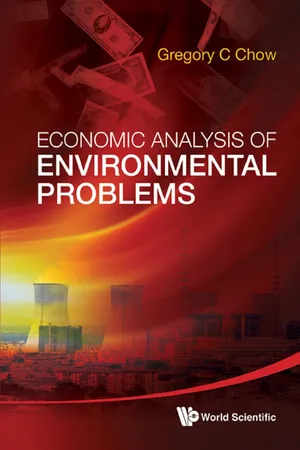
- 208 pages
- English
- ePUB (mobile friendly)
- Available on iOS & Android
Economic Analysis of Environmental Problems
About this book
This book introduces the basic tools of dynamic optimization in economics to study environmental problems, applies econometric methods to estimate and test the models derived by dynamic optimization, and discusses environmental problems in a broad perspective, including the design and implementation of environmental policies. Although the coverage is selective, it represents what the author has to offer from his perspective and experience gained in research in dynamic optimization, econometrics and policy analysis, especially for China.
The volume is self-contained for readers with mathematical background of first-year graduate students in the analytical fields of science and engineering but only limited training in economics, while an economics text presumes more knowledge of economics. Once the tools are mastered, the reader can pursue his own research on the topic if he is interested, or simply become a more mature citizen in the global economy.
Request Inspection Copy
Contents:
- Environmental Economics: Basic Ideas and Analytical Methods
- China's Energy and Environmental Problems and Policies
- Optimal Path for CO 2 Emission to Control Global Warming
- Macroeconomic Models Incorporating the Effect of Pollution
- Stochastic Models to Study the Effect of Climate Change
- Parameter Uncertainty in Models of Global Warming
- Regional Differences in Environmental Policies
- Macroeconomic Models to Explain Pollution and Environmental Protection
- Use of Emission Permits
- Environmental Kuznets Curve
- Clean Energy and International Efforts to Solve Environmental Problems
Readership: Academics, professionals, graduate students involved in the environmental economics.
Key Features:
- This book gives an insight to researchers outside of Korea on why Korean students at elementary and secondary levels consistently achieve high scores in TIMSS and PISA for mathematics
- The book, being in English, will address a wider group of readers globally, particularly to educational theorists and practitioners of mathematics education, as such literature is restricted to a limited amount of papers
Frequently asked questions
- Essential is ideal for learners and professionals who enjoy exploring a wide range of subjects. Access the Essential Library with 800,000+ trusted titles and best-sellers across business, personal growth, and the humanities. Includes unlimited reading time and Standard Read Aloud voice.
- Complete: Perfect for advanced learners and researchers needing full, unrestricted access. Unlock 1.4M+ books across hundreds of subjects, including academic and specialized titles. The Complete Plan also includes advanced features like Premium Read Aloud and Research Assistant.
Please note we cannot support devices running on iOS 13 and Android 7 or earlier. Learn more about using the app.
Information
Table of contents
- Cover
- Half Title
- Title
- Copyrights
- Dedication
- Preface
- About The Author
- Contents
- 1. Environmental Economics: Basic Ideas and Analytical Methods
- 2. China’s Energy and Environmental Problems and Policies
- 3. Optimal Path for CO2 Emission to Control Global Warming
- 4. Macroeconomic Models Incorporating the Effect of Pollution
- 5. Stochastic Models to Study the Effect of Climate Change
- 6. Parameter Uncertainty in Models of Global Warming
- 7. Regional Differences in Environmental Policies
- 8. Macroeconomic Models to Explain Pollution and Environmental Protection
- 9. Use of Emission Permits
- 10. Environmental Kuznets Curve
- 11. Clean Energy and International Efforts to Solve Environmental Problems
- Index